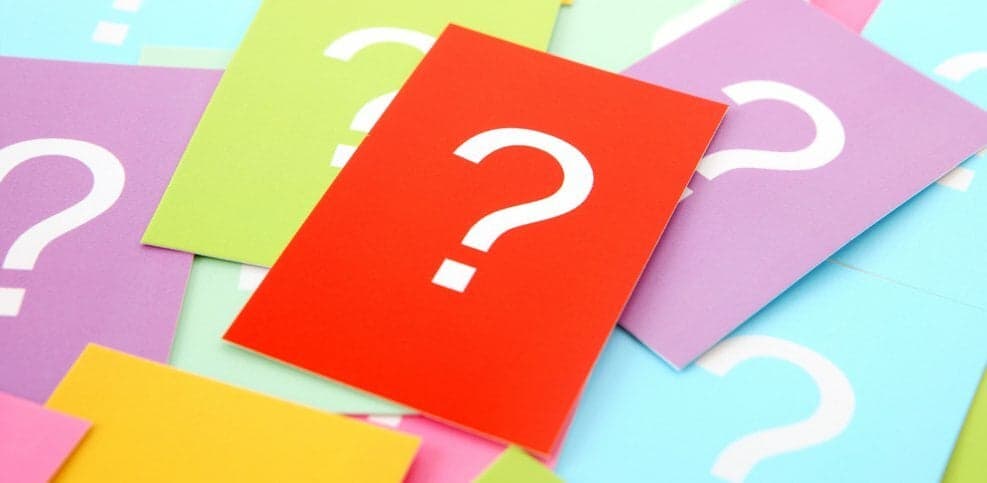Today’s topic is how to format questions. You think you already know this, don’t you? I wonder if you’re right.
Everybody knows how to write a plain vanilla question: What’s new? They’re called direct questions. But there are trickier scenarios. What happens when a sentence seems to be half statement, half question? What if you’re asking an indirect question, or asking a question that also seems to require an exclamation point, or dealing with a quotation that contains a question, and so on?
Questions Masquerading as Statements
Sometimes even direct questions are tricky because they can look like statements, and the only way to tell your reader otherwise is to add a question mark. There’s a big difference in meaning between “He went to the store.” and “He went to the store?” Yet the only difference between the two sentences is that one ends with a period and one ends with a question mark. The question mark makes it a direct question that shows surprise. What the heck was he doing at the store?
A Question Flurry
What if you have a bunch of questions and you want to string them all together?
There’s a funny scene in a movie (I think it was Cats & Dogs) where a dog realizes he can talk, and it goes something like this: You can hear me? Can I have a cookie? two cookies? four cookies? twenty cookies?
Those add-on questions at the end aren’t complete sentences but they each get a question mark anyway. It reads Can I have a cookie? two cookies? four cookies? and so on. They aren’t complete sentences, so you don’t usually capitalize the first letter. The rules are vague, though. Some books say to capitalize the first letter if the questions are “nearly a sentence” or have “sentence-like status”, so you have to use your own judgment. I don’t consider “two cookies” to be nearly a sentence, but I may consider something like “two cookies and a squeaking ball to chase” to be nearly a sentence, which would make me think about capitalizing it.
Statements With Tag Questions
Now, what about those little questions that come at the end of a statement? You didn’t forget my birthday, did you? It’s fun to play marimbas, isn’t it?
Bits like did you and isn’t it are called tag questions and they turn the whole sentence into a question, so use a question mark at the end.
Indirect Questions
Do you have a curious nature? Do you wonder about things? When you wonder, your statements might sound like questions, but they’re not direct questions, they’re indirect questions, and they don’t take a question mark. For example, I wonder why he went to the store. It’s an indirect question—essentially a statement—so there’s no question mark. I wonder if Squiggly would loan me his marimbas. Again, it’s not a question.
Questions in Quotation Marks
Next, where do you put the question mark when you’re using quotation marks? It depends on the sentence—is the whole thing a big question, or is only the part in quotation marks a question?
If the whole sentence is a question, then you put the question mark outside the quotation mark. Here’s an example: What do you think Squiggly meant when he said, “The fish swam darkly up the river”? The whole sentence is a question, so the question mark goes at the very end (outside the quotation mark).
On the other hand, if only the quotation is a question, then the question mark goes inside the quotation mark. Here’s an example: Squiggly ran up to Aardvark and asked, “Where are the fish?” The question mark goes inside the quotation mark because the only part of the sentence that is a question is Where are the fish?
It helps to remember that the question mark stays attached to the question whether it is the whole sentence or just the quotation.
Indirect Questions Mixed with Direct Questions
It gets really crazy when you start mixing direct and indirect questions together. There are multiple ways to write something like The question at hand is, who stole the cookies? The simplest way to write that is to put a comma after the indirect question and a question mark after the direct question: The question at hand is, who stole the cookies?
Believe it or not, some style guides allow you to capitalize the first word in a direct question, even though it comes in the middle of a sentence: The question at hand is, Who stole the cookies? Supposedly, capitalizing the first word in the question places more emphasis on the question, but I think it makes the sentence look disjointed.
And if you think that looks weird, it gets even worse. If you flip the two parts around, you can put a question mark in the middle of your sentence: Who stole the cookies? was the question at hand.
It’s good to know the rules, but these sentences seem so contorted that I think it is better to try to rewrite them. I could easily convert the sentence to an indirect question: Everyone wondered who stole the cookies. Or I could use a colon to make the punctuation less odd: One question remained: Who stole the cookies?
Polite Requests
Here’s another strange rule: Some style guides say that polite requests phrased as questions get a period instead of a question mark. For instance, they recommend putting a period at the end of a sentence like Would you bring me the marimbas. I find this very odd, since it is clearly a question, but the rationale is that it is really a demand masquerading as a question.
Surprising Questions
Finally, when you’re asking a question in surprise such as What? it isn’t appropriate to use multiple question marks or a question mark with an exclamation point. You’re supposed to pick the terminal punctuation mark that is most appropriate and use just one. Is your statement more of a question or more of an outburst?
I’ve always found that solution unsatisfactory, so I was thrilled to learn that there’s an obscure punctuation mark that was designed exclusively for asking questions in a surprised manner. It’s called an interrobang, and it looks like an exclamation point superimposed on a question mark.
You shouldn’t use the interrobang in formal writing, but I think it would be great if people started using it on blogs and in other informal communications. If you have the Wingdings 2 font in your word processing program, you can insert an interrobang as a special character, and there are unicode values that you can use to add the interrobang to your web site.
More From Quick and Dirty Tips
This article was originally published on Quick and Dirty Tips. It has been republished here with permission.

